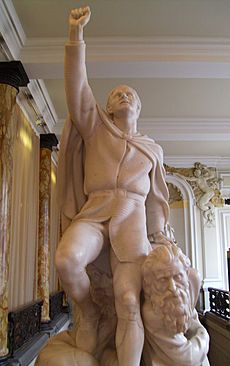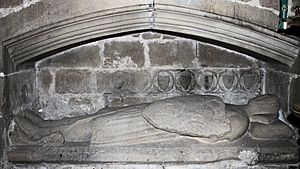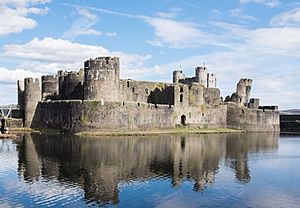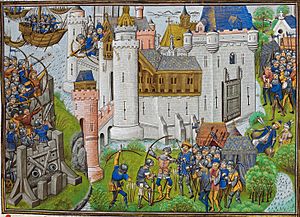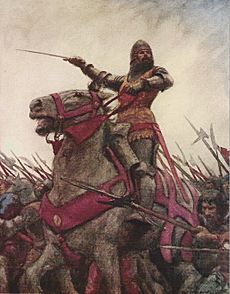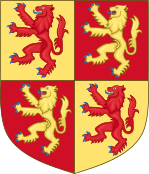Welsh rebellions against English rule facts for kids

After King Edward I took control of Wales in 1283, Welsh people were unhappy with English rule. This led to several rebellions over the next 100 years. In 1400, a big uprising called the Welsh Revolt began. It was led by Owain Glyndŵr, who became very powerful and controlled much of Wales for a few years. The rebellion slowly ended after 1409, and by 1415, England was fully in charge again. After this, there were no more big rebellions.
Contents
How Wales Lost Its Independence
Llywelyn ab Iorwerth was the first Welsh leader to unite Wales. In 1218, the English King Henry III officially called him "Prince of Wales." However, Llywelyn's son, Dafydd ap Llywelyn, lost some of these lands. Later, Llywelyn's nephew, Llywelyn ap Gruffudd, brought Wales together again. He ruled from 1246 to 1282 and also used the title "Prince of Wales" starting in 1258.
Edward I's Conquest
In 1276, King Edward I of England declared war on Llywelyn ap Gruffudd. Edward led a large army into Wales in 1277. Llywelyn saw that he could not win and gave up without a fight. Edward made a deal instead of conquering Wales completely.
But war started again in 1282. This happened because Llywelyn's brother, Dafydd ap Gruffydd, was unhappy with what Edward had given him. Edward I was pulled back into the war, but this time he decided to fully conquer Wales.
The war changed when Llywelyn ap Gruffudd marched into mid-Wales. He was tricked and killed at the Battle of Orewin Bridge in December 1282. Dafydd took over as leader, but he was captured in 1283. He was executed in Shrewsbury.
After Llywelyn and Dafydd died, Edward I ended Wales's independence. In 1284, he introduced the Statute of Rhuddlan. This law officially joined the Principality of Wales with England. It brought English laws to Wales for criminal cases, but Welsh laws were still used for civil cases.
Early Welsh Rebellions
Rhys ap Maredudd's Uprising (1287–1288)
Rhys ap Maredudd was a Welsh leader who started a revolt in south Wales in 1287. Earlier, in 1277, Rhys had agreed to follow King Edward I. He even helped Edward during the war in 1282.
However, Rhys later rebelled against Edward in June 1287. He attacked English strongholds across west Wales. Edward's soldiers quickly moved to stop him. They captured Rhys's castles, Dryslwyn and Newcastle Emlyn. Rhys became a fugitive, meaning he was on the run. He was finally caught and executed in 1292 in York.
Madog ap Llywelyn's Revolt (1294–1295)
Madog ap Llywelyn led a big Welsh revolt against English rule in 1294. He was even called "Prince of Wales." The revolt began because of new English officials and new taxes. Madog was related to earlier Welsh princes, so he claimed to be the rightful leader.
The uprising was planned for months, with attacks happening all over Wales on the same day. While Madog led the north, other leaders like Cynan ap Maredudd and Morgan ap Maredudd led revolts in mid and south Wales. King Edward I was planning to go to France, but bad weather stopped him. He quickly cancelled his French trip to deal with the Welsh uprising.
In December 1294, King Edward led his army into north Wales. He reached Conwy Castle just before Christmas. Some castles, like Harlech Castle, were in great danger. Edward himself was ambushed and had to retreat to Conwy Castle, where he was surrounded until his navy rescued him.
The most important battle was the Battle of Maes Moydog in March 1295. Madog's Welsh army was surprised by the English. The Welsh soldiers used a special formation, like a "porcupine" with pikes, to defend against English knights. However, English archers caused many losses. Many Welsh soldiers drowned trying to cross a swollen river while escaping. Madog barely escaped and was a fugitive until he was captured in July or August 1295.
Llywelyn Bren's Uprising (1316)
Llywelyn Bren was a Welsh nobleman who led a revolt in 1316 during the reign of King Edward II of England. When he was told to appear before the king, Llywelyn instead gathered a Welsh army. They attacked Caerphilly Castle. The rebellion spread across south Wales, and other castles were attacked.
However, this uprising only lasted a few weeks. It was the last major challenge to English rule in Wales until Owain Lawgoch tried to invade with French help in the 1370s. Llywelyn Bren was later executed.
Owain Lawgoch's Attempts (1370s)
In 1372, Owain Lawgoch announced in Paris that he wanted to claim the throne of Wales. He sailed from France with money from the French king. Owain first attacked the island of Guernsey. But then he was told to stop and go to Spain to get ships to attack a French town.
In 1377, there were reports that Owain was planning another expedition, this time with help from Spain. The English government was worried. They sent a spy named John Lamb to kill Owain. Owain was busy besieging a town in France. Lamb gained Owain's trust and became his assistant. This gave him the chance to kill Owain in July 1378. Owain was buried in France.
With Owain Lawgoch's death, the main royal family line of Wales ended. This meant that the claim to be "Prince of Wales" passed to other Welsh royal families. The most important heir was Owain Glyndŵr, who was related to both of these families.
The Great Welsh Revolt Led by Owain Glyndŵr
The main reason for Owain Glyndŵr's rebellion was a disagreement over land with an English lord, Baron Grey of Ruthin. Also, a letter asking Glyndŵr to provide soldiers for King Henry IV of England was delivered late, and the English king did not fairly settle the dispute.
On September 16, 1400, Glyndŵr was declared "Prince of Wales" in Glyndyfrdwy. With his armies, he began attacking English towns in north-east Wales using guerrilla tactics. This meant they would attack quickly and then disappear into the mountains. Glyndŵr gained a lot of support across Wales. King Henry IV tried to invade Wales several times but had little success. Bad weather and Glyndŵr's clever tactics made him seem like a mythical figure who could control the weather.
Unfair Laws and Growing Support
The English quickly responded by passing a series of unfair laws in 1401 and 1402. These laws were meant to stop the rebellion and show English power. However, they made Welsh people even angrier, which caused more people to join Glyndŵr's side.
In 1404, Glyndŵr captured Aberystwyth Castle and Harlech Castle. He also made an agreement with France and held a Welsh parliament, called a Senedd, in Machynlleth. He was crowned Prince of Wales, with representatives from Scotland, France, and Spain present. French help arrived in 1405, and Glyndŵr controlled most of Wales.
In 1406, Glyndŵr wrote the Pennal Letter. In this letter, he offered Welsh loyalty to a different Pope and asked for St Davids to be the main church in Wales. He also wanted Welsh-speaking priests, two Welsh universities, and for Welsh church money to stay in Wales. He asked for King Henry IV to be removed from the church. However, the French did not respond, and the rebellion began to weaken.
The End of the Revolt
Aberystwyth Castle was lost in 1408, and Harlech Castle fell in 1409. Glyndŵr was forced to retreat into the Welsh mountains. From there, he continued to lead occasional guerrilla raids. It is believed he died in 1416 at his daughter Alys's home near the Welsh-English border.
Glyndŵr's legacy was the unfair laws that stayed in place long after the rebellion. These laws made Welsh people feel like second-class citizens in their own country until they were finally removed in the 1500s. With hopes of independence gone, there were no more wars or rebellions against English rule. Today, Glyndŵr remains an important symbol of Welsh identity and pride.
See also


